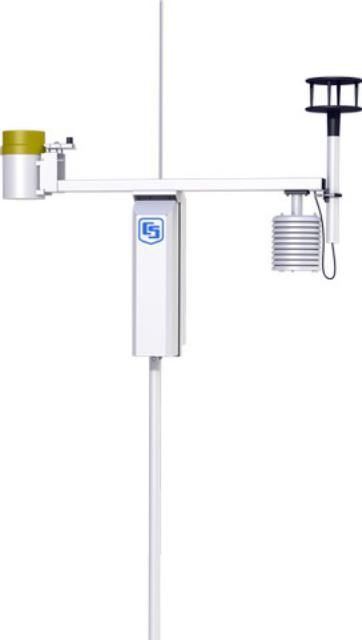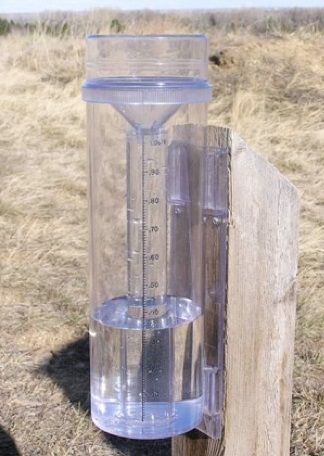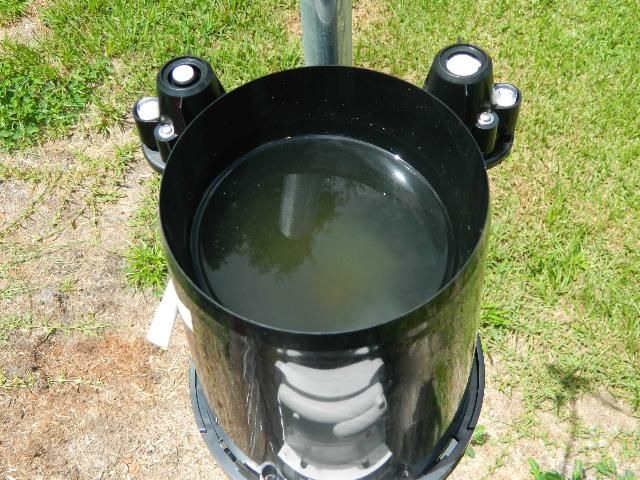Introduction
Weather is a prominent factor in the success or failure of agricultural enterprises. With the advent of improved and less expensive technology, many farmers are installing farm-based weather stations to track weather conditions, schedule irrigation, make decisions related to cold protection, and accomplish other tasks.
Although installation of a weather station provides farmers with a unique opportunity to better understand how weather interacts with their crops and livestock, conclusions and decisions must be based on high-quality observations. High-quality weather observations require (1) sensors that meet accepted minimum accuracy standards, (2) proper siting of the station, and (3) good maintenance. This publication intends to provide farmers with basic guidelines for installing and maintaining a weather station.

Credit: Campbell Scientific
Purchasing a Station with Accurate Sensors
Before selecting and purchasing a weather station, some important questions must be answered. For example, what is the purpose of the weather station, and which weather variables are important? It is important to consider observational range and accuracy of the sensors.
If interested in only tracking rainfall, a good quality rain gauge such as the one used by the Community Collaborative Rain, Hail & Snow project, or CoCoRaHS (http://www.cocorahs.org/), would be adequate—CoCoRaHS teaches users how to manually measure daily rainfall and then submit the observations to their website. If the main concern is cold protection, then air temperature and other variables such as relative humidity and wet bulb temperature are critical. If scheduling irrigation is important, estimating reference evapotranspiration (ETo) is necessary, and it requires a larger set of variables, including solar radiation, wind speed, relative humidity, and air temperature. Similarly, certain plant-disease risk models use leaf wetness duration, which requires a specific sensor.
Manufacturers offer stations equipped with sensors that have varying observational ranges and accuracy. For example, relative humidity (RH) sensors can output different levels of accuracy depending on their observational range, with the typical accuracy for a medium cost weather station sensor being ±3% below 90% RH, and ±4%–5% above 90% RH. Lower accuracy for readings above 90% RH can be a problem if RH is being used to estimate leaf wetness duration for use in a mathematical model. On the other hand, the typical accuracy of air temperature sensors on a medium cost weather station is ±1°F across their entire observational range. Therefore, it is important to purchase sensors with the observational range and accuracy that will best support the desired application (e.g., cold protection, irrigation scheduling, and modeling).

Credit: CoCoRAHS
Proper Siting of the Station
Selecting an appropriate site for your weather station is critical to obtaining useful weather observations. The site should be representative of the area of interest. For agricultural applications, the station should be located in a place that best represents field conditions. Stations located at airports or in urban environments are not appropriate for agricultural applications due to the high spatial variability of rainfall and the influence of built environments on temperature. Stations should be sited in order to minimize the influence that obstructions, such as buildings and trees, can have on observations. Perfect siting is not always possible but, depending on the application and sensors installed, the following rules should be observed:
a. Wind speed and direction: Wind sensors should be located over open, level terrain as far away from any nearby obstructions (e.g., buildings, trees) as possible—ideally a distance equal to 10 times the height of the closest obstruction.
b. Temperature and relative humidity: Temperature and relative humidity sensors should be located over an open, level area at least 10 m (about 30 ft) in diameter. The surface should be covered with short grass or another natural surface. These sensors should be located a distance of at least 4 times the height of any nearby obstruction, or at least 30 m (about 100 ft), from large paved areas. Sensors should be protected (or shielded) from thermal radiation and ventilated. Rooftops, steep slopes, high vegetation, shaded areas, swamps, low places that hold standing water after rains, and large industrial heat sources should be avoided.
c. Solar radiation: In the Northern Hemisphere, sensors should be mounted on the southernmost side of the station to prevent exposure to shadows. Reflective surfaces and artificial radiation sources should be avoided. Ensure tall trees and/or other structures will not shade the sensor as the angle of the sun changes throughout the year.
d. Soil moisture and temperature: Soil moisture/temperature should be measured in an area at least 1 m2 (about 10 ft2) that represents the soils in the fields of interest. The sensors should be installed at least 1.5 m (about 5 feet) from any tower or structure and away from areas where natural drainage from surrounding areas occurs. Soil temperature and moisture can be observed at different depths in the soil, but temperature is typically observed at 10 cm (4 in) below the surface, and moisture is typically observed at various depths, depending on the application of the measurement. If temperature is measured at a single depth, a depth that best represents root zone conditions is recommended.
e. Rain gauge: Rain gauges should placed as far away from obstructions as possible, ideally a distance equal to four times the height of the closest obstruction. The collector of the rain gauge must be in a horizontal plane, level, open to the sky, and above the height at which splashing rain and snow accumulation can influence the measurement.
f. Leaf wetness: Leaf wetness sensors should be installed at a height of 30 cm, facing north in the Northern Hemisphere south in the Southern Hemisphere) at a 45° angle to the ground. The surface of the ground should be covered with short grass. The sensor should be placed in a location that is not affected by irrigation sprinklers or other sources of moisture.
Table 1 summarizes the above recommendations for agro-meteorological stations (which may differ from recommendations of the World Meteorological Organization and other agencies).
Local Maintenance Guidelines
It is common to find problems with data observed at weather stations that are not properly maintained—the only thing worse than no data is wrong data. Data clean-up may cost more than simply keeping a weather station in good working condition. Table 2 summarizes maintenance tips for the various sensors.
The power supply of the weather station should be checked regularly. Rechargeable power supplies should be connected to an AC power source to serve as a backup when the power supply fails. A solar panel can provide power to weather stations located away from AC power to operate the station during the day and charge a battery for nighttime operation. An occasional cleaning of the glass on the solar panel will improve its efficiency. Use warm, mildly soapy water and a clean cloth, and then rinse with clean water.
Weather data has many applications. Accurately scheduling irrigation and/or cold protection, for example, is very difficult, if not impossible, without reliable weather data. Proper maintenance of a weather station is imperative and will ensure the station is collecting data that is useful across many applications.

Credit: C. Fraisse (2014)
Conclusion
In summary, although installing a weather station provides farmers with a unique opportunity to better understand how weather interacts with their crops and their livestock, the proper selection of station and sensors, siting of the station, and regular maintenance are extremely important for the successful use of weather information in agricultural enterprises.
References
Brown, P., and B. Russell. 2010. Siting and Maintenance of Weather Stations. Turf Irrigation Management Series: III. Arizona Cooperative Extension. College of Agricultural and Life Sciences. AZ1260.
Campbell Scientific. 2015. "Weather Station Siting." Accessed February 27. http://www.campbellsci.com/weather-station-siting